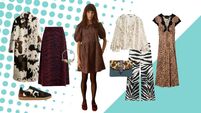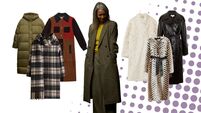Paul McLauchlan: Your guide to men's jewellery and how to wear it

When the American jeweller, Maria Tash, was designing her latest collection, she knew she wanted to make something for the boys too.
Tash’s jewellery is designed for both men and women but it’s traditionally favoured by our female counterparts. For the latest collection, men appear alongside women in the advertising campaign.
“I don’t design with gender in mind,” says Tash.
Men’s jewellery is a growing space with an increasing amount of visibility. From Connell Waldron’s gold chain in Normal People attracting some 187,000 followers on an Instagram fan account to the heavily embellished models on the runway at Gucci, men have become more decorated in their approach to styling.
From celebrities like Harry Styles sporting a signet ring at live performances to Colombian singer, J Balvin, stacking colourful beaded bracelets from Florentine jeweller, Carolina Bucci — men’s interest in accessories is greater now than ever.
Maria Tash is just one of many with a proposition for men. Her latest collection, which has just launched in Brown Thomas, features a host of new styles that blend movement with structure: angular designs glistening with diamonds and backed with gold, silver and rose gold hardware, suitable for ear and helix piercings. The more elaborate the diamond, the more expensive the piece.
Out of Ireland, Dána Project is a sustainable jeweller specialising in handcrafted sterling silver rings and bangles.

The pieces are made in Dublin by goldsmiths based just off Grafton Street. Cillian Hilliard, the founder, finds that sales of the unisex jewellery are split evenly between men and women.
Le Gramme’s Erwan Le Louer is committed to creating minimal jewellery that responds to men who either want to broaden their horizons by wearing jewellery in a discrete fashion or those who want to expand their existing collection.
“10 years ago, most men simply had a wedding band. Now, men are buying more and more jewellery and many of them are interested in sustainability too,” said Hilliard, the founder of Dána Project, which hopes to challenge jewellery companies to become more sustainable in terms of their production, materials, values, and everything else right down to packaging.

“Men are increasingly emancipating themselves and reconnecting with jewellery,” said Le Gramme founder, Erwan Le Louër.
Le Louër remarks that men’s jewellery falls into two categories: the man who is interested in jewellery for himself, and jewellery as a gift.
“When it comes to designing for men, I think choice of material is important and it needs to be recognisable,” said Tomasz Donocik, a Polish-Austrian jeweller based in London.
Donocik finds that men who wear jewellery are typically drawn to symbols of masculinity such as studs, skulls, dog tags, crosses and anything tribal. In terms of materials, he associates anchors, ropes, hooks, shackles with men’s jewellery.
Damien Paul, head of menswear at MATCHESFASHION, presumes the interest in jewellery arises from recent cultural touchstones: “You can’t underestimate how something like Connell’s chain in Normal People resonates beyond popular culture and into customer purchasing. We have seen gold is performing well."

Paul cites Alighieiri and Bleue Burnham as brands that resonate with customers.
Of course, the early 2000s and the associated ostentatious styles popularised jewellery for men in the modern era long before its current renaissance. Men such as David Beckham and Johnny Depp were known for accessorising with diamond earrings. Furthermore, throughout history, men bedecked themselves in regalia as a means of displaying their grandstanding role in society.
“Sportsmen, musicians, actors have all played a key influence in the acceptance of jewellery and certainly in the last couple of years jewellery has evolved from refined, subtle pieces to more ornate pieces, necklaces and bracelets adorned with trinkets and coins,” says Paul.

Paul has noticed that since our lives have increasingly migrated online due to the pandemic, pieces such as necklaces can become a focal point in Zoom meetings, in the same way that a colleague might have noticed Italian-made shoes in the boardroom.
“Men now understand that fine details are important — they are understanding that jewellery is noticed and commented on and they have embraced it,” says Paul.
Le Louër is not as convinced by a specific need for jewellery for working from home, though he acknowledges that jewellery “allows men to assert their personality and to continue to have a positive outlook during this particular period".
While the pandemic has forced people to be more financially conscientious, jewellery sales have continued to perform. In the first six weeks of lockdown sales of jewellery doubled at MATCHES.
In keeping with this, jewellery is a growing category for the online retailer. Over the last year, the buyer’s selection increased by more than 60%. Le Gramme noticed sales plummet from mid-March to the end of April but things picked back up again with growth that “we had not anticipated” since the beginning of May. Dána Project, based online, hasn’t noticed an overwhelming hit to sales.
Jewellery, valued for how precious and delicate it is, can function as a salve to the tumult of the times. When society seems a bit bleak, it is finding joy in the precious things that can matter most.







